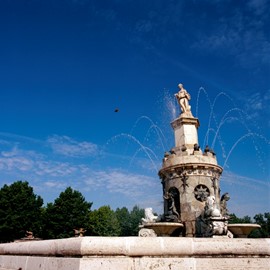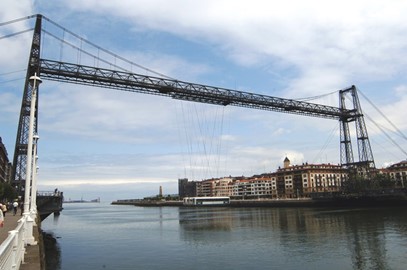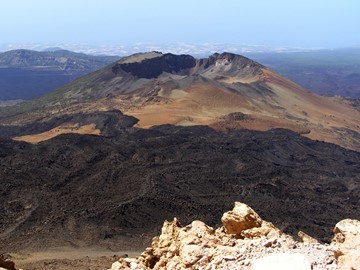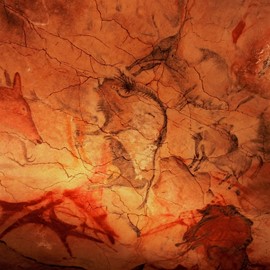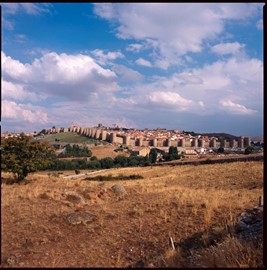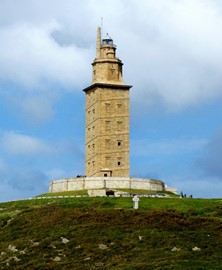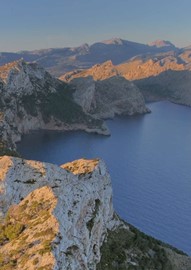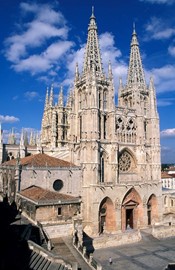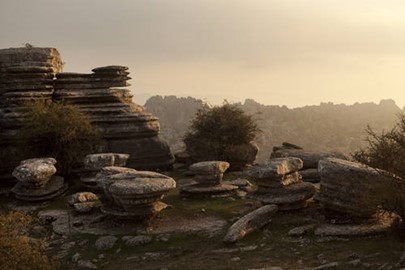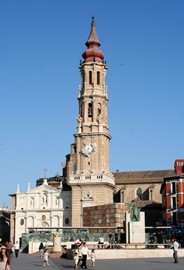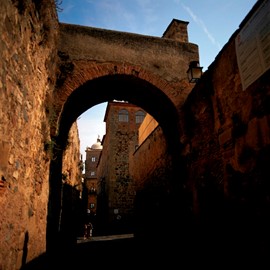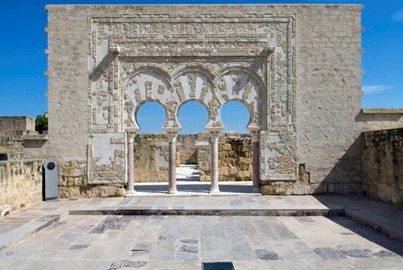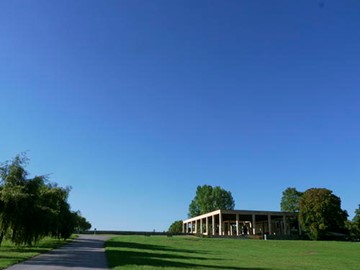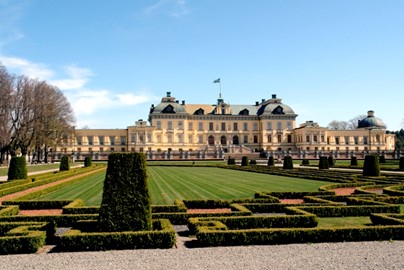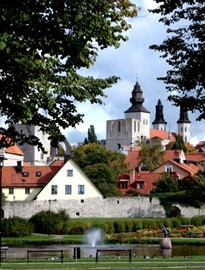region :: europe and north america
Roman Walls of Lugo
The Roman Walls of Lugo, a UNESCO World Heritage site in Spain, are an exceptionally well-preserved example of Roman military architecture from the 3rd century AD. Constructed under Emperor Augustus, these fortifications stretch over 2 kilometers, featuring 85 semicircular towers and multiple gates, built with slate and granite. Originally designed to protect the Roman city of Lucus Augusti, the walls remain largely intact, offering a unique glimpse into ancient engineering and urban planning. Today, they s... Read More
Vall de Boí
Vall de Boí, a UNESCO World Heritage site in Spain, is renowned for its exceptional collection of Romanesque churches dating back to the 11th and 12th centuries. These well-preserved structures, including notable examples like Sant Climent de Taüll and Santa Maria de Taüll, showcase stunning architecture and intricate frescoes that reflect the region's medieval cultural and religious significance. The site’s historical importance and artistic value make it a remarkable testament to Catalonia’s Romanesque he... Read More
Atapuerca
The Archaeological Site of Atapuerca, a UNESCO World Heritage site in Spain, is renowned for its exceptional prehistoric findings, offering critical insights into early human evolution. Excavations have uncovered fossils and tools dating back over a million years, including remains of some of the earliest known hominins in Western Europe. The site's well-preserved evidence has significantly advanced scientific understanding of human ancestry and prehistoric life.
Aranjuez
The Aranjuez Cultural Landscape, a UNESCO World Heritage site, is a remarkable example of a human-shaped environment blending nature and culture. It features an intricate network of historic gardens, orchards, and waterways, alongside elegant palaces and architectural treasures, reflecting centuries of royal influence and innovative land management. This harmonious fusion of Baroque and Renaissance styles with the surrounding natural beauty showcases a unique legacy of artistic and environmental planning. I... Read More
Vizcaya Bridge
The Vizcaya Bridge, a UNESCO World Heritage site in Spain, is an iconic transporter bridge completed in 1893, designed by architect Alberto de Palacio. It stands as a remarkable feat of industrial engineering, blending iron construction with innovative technology to ferry passengers and vehicles across the river via a suspended gondola. Recognized for its historical and architectural significance, it symbolizes the ingenuity of the late 19th century and remains operational today.
Teide
Teide National Park, a UNESCO World Heritage site in Spain, is renowned for its stunning volcanic landscape, dominated by Mount Teide, the country’s highest peak. The park features dramatic lava fields, unique rock formations, and a diverse range of endemic flora and fauna adapted to its high-altitude environment. Its geological significance and breathtaking scenery make it a globally recognized natural treasure, attracting visitors for hiking, stargazing, and scientific exploration.
Altamira Cave
Altamira Cave, a UNESCO World Heritage site in Spain, is renowned for its prehistoric rock art, dating back to the Upper Paleolithic period, approximately 36,000 to 13,000 years ago. Discovered in 1868, the cave features remarkable polychrome paintings and engravings of bison, horses, and other animals, created using charcoal, ochre, and natural contours of the rock. Often called the 'Sistine Chapel of Prehistoric Art,' it provides invaluable insight into early human creativity and culture. Due to preservat... Read More
Ávila
The Old Town of Ávila, a UNESCO World Heritage site in Spain, is renowned for its well-preserved medieval architecture, including its iconic city walls constructed in the 11th century. These walls, featuring 88 towers and nine gates, encircle a historic center filled with Romanesque and Gothic churches, such as the Ávila Cathedral, begun in 1091. The site reflects a blend of military, religious, and cultural influences, showcasing Spain’s rich historical legacy. Its significance lies in its exemplary urban ... Read More
Tower of Hercules
The Tower of Hercules is an ancient Roman lighthouse and UNESCO World Heritage site, recognized for its historical and architectural significance. Built in the 1st century AD, it stands as the oldest functioning lighthouse in the world, originally constructed to guide ships along the Atlantic coast. Its robust stone structure, later renovated in the 18th century, blends Roman engineering with neoclassical design, symbolizing centuries of maritime heritage. Today, it serves as both a navigational aid and a c... Read More
Palau de la Música Catalana
The Palau de la Música Catalana and Hospital de Sant Pau are two UNESCO World Heritage sites in Spain, celebrated for their architectural brilliance and cultural significance. The Palau, designed by Lluís Domènech i Montaner, is a stunning concert hall known for its intricate modernist design, featuring vibrant stained glass and ornate details. Nearby, the Hospital de Sant Pau, also by Domènech i Montaner, showcases a unique blend of functionality and artistry with its decorative pavilions and gardens. Toge... Read More
Seville
The Cathedral, Alcázar, and Archivo de Indias in Seville form a UNESCO World Heritage site renowned for their historical and architectural significance. The Cathedral, a grand Gothic masterpiece, houses the tomb of Christopher Columbus and features the iconic Giralda tower. Adjacent to it, the Alcázar, a stunning royal palace, showcases Mudéjar architecture with intricate tilework and lush gardens. Nearby, the Archivo de Indias preserves invaluable documents from Spain’s colonial era, reflecting its maritim... Read More
Serra de Tramuntana
The Cultural Landscape of the Serra de Tramuntana, a UNESCO World Heritage site in Spain, is a stunning example of human adaptation to a rugged mountainous environment. This unique region showcases an intricate network of terraces, stone walls, and water management systems developed over centuries, primarily for olive and vineyard cultivation. Its historical significance lies in the blend of Islamic and Christian agricultural traditions, reflecting a harmonious coexistence with nature. The site’s picturesqu... Read More
Routes of Santiago de Compostela: Camino Francés and Northern Spain
The Routes of Santiago de Compostela, recognized as a UNESCO World Heritage site, encompass the Camino Francés and other historic pilgrimage paths leading to the shrine of St. James in Santiago de Compostela. These routes, traveled by pilgrims since the Middle Ages, are celebrated for their cultural and historical significance, featuring a network of trails dotted with churches, monasteries, and hostels. The Camino Francés, the most famous route, highlights the architectural and spiritual legacy of this end... Read More
Burgos Cathedral
Burgos Cathedral, a UNESCO World Heritage site in Spain, is a stunning Gothic masterpiece begun in 1221 and completed over centuries. Its intricate facade, adorned with spires and sculptures, showcases exceptional architectural artistry. The cathedral houses notable treasures, including the tomb of El Cid and a golden staircase by Diego de Siloé. Renowned for its historical and cultural significance, it remains a prominent symbol of Spanish heritage.
Antequera Dolmens Site
The Antequera Dolmens Site, a UNESCO World Heritage site in Spain, comprises three prehistoric megalithic monuments: the Menga Dolmen, Viera Dolmen, and Tholos of El Romeral. Dating back to the Neolithic and Bronze Age periods, these structures showcase exceptional engineering and architectural skills of ancient communities, built using large stone blocks. The site also includes two natural monuments, La Peña de los Enamorados and El Torcal, which enhance its cultural and historical significance. Recognized... Read More
Segovia
The Old Town of Segovia and its Aqueduct, a UNESCO World Heritage site in Spain, is a remarkably preserved historic ensemble showcasing Roman engineering and medieval architecture. The iconic Roman aqueduct, constructed in the 1st century AD, stands as one of the best-preserved structures of its kind, channeling water across a dramatic stone-arched span. Complementing this, the Old Town features a picturesque blend of Gothic and Renaissance buildings, including a stunning cathedral and a fairy-tale-like alc... Read More
Mudejar Architecture of Aragon
Mudejar Architecture of Aragon, a UNESCO World Heritage site, exemplifies a unique blend of Islamic and Christian artistic traditions from the 12th to 17th centuries. This style features intricate brickwork, horseshoe arches, and ornate stucco work, reflecting the cultural coexistence of Muslim, Christian, and Jewish communities. Notable examples include churches and towers that showcase this hybrid aesthetic, preserved as a testament to medieval craftsmanship and historical harmony.
Cáceres
The Old Town of Cáceres, a UNESCO World Heritage site in Spain, is a remarkably preserved medieval ensemble featuring a blend of Roman, Islamic, Gothic, and Renaissance architecture. Its historic core boasts narrow cobblestone streets, ancient stone walls, and notable landmarks like the Santa María Cathedral and the Torre de Bujaco, reflecting centuries of cultural influences. This well-maintained urban landscape offers a glimpse into Spain’s rich historical past, attracting visitors with its timeless charm... Read More
Medina Azahara
Medina Azahara, a UNESCO World Heritage site in Spain, is a remarkably preserved 10th-century palace-city built by the Umayyad Caliph Abd al-Rahman III. Constructed as a symbol of power and grandeur, it features intricate architecture, including ornate stucco work, horseshoe arches, and expansive courtyards. Abandoned after less than a century, the site offers a unique glimpse into the sophistication of Islamic civilization in Al-Andalus. Today, it stands as a testament to the region’s rich historical and c... Read More
Birka and Hovgarden
Birka and Hovgården, a UNESCO World Heritage site in Sweden, form a remarkable archaeological complex showcasing the Viking Age's extensive trading networks across Europe. Located on two neighboring islands in Lake Mälaren, Birka was a bustling mercantile town from the 8th to 10th centuries, known for its role as a key trading hub and the site of Sweden’s first Christian congregation, founded in 831 by St. Ansgar. Hovgården, the nearby royal estate, governed the region and features monumental mounds, a rune... Read More
Engelsberg Ironworks
Engelsberg Ironworks, a UNESCO World Heritage site in Sweden, is a remarkably preserved industrial complex established in 1681. It became one of the world’s most advanced ironworks between 1700 and 1800, producing high-quality iron that solidified Sweden’s leadership in the industry during the 17th and 18th centuries. The site features intact buildings, including a blast furnace, forge, and workers’ residences, showcasing historical technology and architecture. Operations ceased in 1919, and it was designat... Read More
Rock Carvings in Tanum
The Rock Carvings in Tanum, a UNESCO World Heritage site in Sweden, are an exceptional collection of Bronze Age petroglyphs dating back to 1800–500 BCE. These ancient artworks, etched into smooth rock surfaces, depict a vivid array of human figures, animals, boats, and weapons, offering a glimpse into the daily life, beliefs, and rituals of prehistoric communities. Recognized for their outstanding universal value, the carvings provide a remarkable archaeological record of northern Europe's early societies.
Skogskyrkogarden
Skogskyrkogården, a UNESCO World Heritage site in Sweden, is a remarkable cemetery designed by architects Gunnar Asplund and Sigurd Lewerentz between 1917 and 1920. Known for its harmonious blend of nature and modernist architecture, it features serene landscapes, minimalist chapels, and a tranquil atmosphere that reflects Scandinavian design principles. The site serves as both a functional burial ground and a cultural landmark, attracting visitors for its historical significance and peaceful beauty.
Drottningholm
The Royal Domain of Drottningholm, a UNESCO World Heritage site in Sweden, is a well-preserved historical ensemble featuring a 17th-century palace, a picturesque theater, and a Chinese Pavilion. Originally built as a royal summer residence, it showcases Baroque architecture and beautifully landscaped gardens, reflecting the grandeur of European royal estates. Today, it serves as a residence for the Swedish royal family while remaining open to the public as a cultural treasure, offering insight into Sweden’s... Read More
Visby
The Hanseatic Town of Visby, a UNESCO World Heritage site in Sweden, is a remarkably preserved medieval trading center on the island of Gotland. Its 13th-century ramparts, over 200 warehouses, and historic churches, like the Sankta Maria Cathedral, showcase its past as a key Baltic Sea hub within the Hanseatic League. The town's cobblestone streets and well-maintained ruins offer a glimpse into its prosperous history, making it a standout example of Northern European medieval architecture and urban planning... Read More



